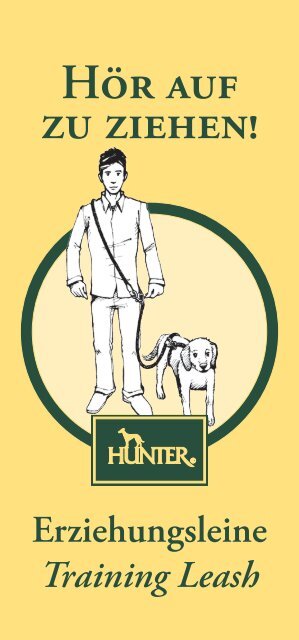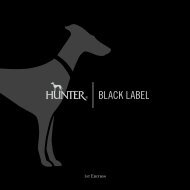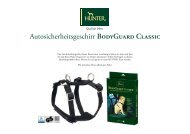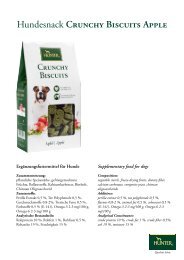Hör auf zu ziehen! - Hunter
Hör auf zu ziehen! - Hunter
Hör auf zu ziehen! - Hunter
Erfolgreiche ePaper selbst erstellen
Machen Sie aus Ihren PDF Publikationen ein blätterbares Flipbook mit unserer einzigartigen Google optimierten e-Paper Software.
Hör <strong>auf</strong><br />
<strong>zu</strong> <strong>ziehen</strong>!<br />
Erziehungsleine<br />
Training Leash
1<br />
2<br />
3<br />
4<br />
5<br />
6<br />
7
Erziehungsleine<br />
Hör <strong>auf</strong> <strong>zu</strong> <strong>ziehen</strong><br />
Ihr Hund zieht an der Leine, und<br />
Sie können ihm dieses Verhalten<br />
einfach nicht abgewöhnen? Die<br />
Erziehungsleine Hör <strong>auf</strong> <strong>zu</strong><br />
<strong>ziehen</strong> verspricht Hilfe. Läuft der<br />
Hund entspannt neben seinem<br />
Menschen, liegt die Leine locker<br />
um seinen Bauch. Wird der Hund<br />
schneller und übt damit einen Zug<br />
<strong>auf</strong> die Leine aus, spannt sich diese<br />
sofort um seinen Bauch, wor<strong>auf</strong>hin<br />
er langsamer wird oder stehen<br />
bleibt. Nun sollte der Mensch<br />
sofort reagieren und den Hund für<br />
das erwünschte Verhalten loben<br />
und belohnen. Durch die richtige<br />
Handhabung und zeitnahe positive<br />
Verstärkung des erwünschten Verhaltens<br />
lernt Ihr Hund sehr schnell,<br />
was Sie von ihm erwarten! Die<br />
Erziehungsleine muss daher auch<br />
nicht dauerhaft <strong>zu</strong> diesem Zweck<br />
eingesetzt werden. Mit ein paar<br />
einfachen Handgriffen wird sie <strong>zu</strong>r<br />
Umhänge- oder langen Führleine.
1<br />
2<br />
3<br />
5<br />
3<br />
4
Gebrauchshinweise:<br />
··<br />
Der Stopp-Ring (1) wird so eingestellt,<br />
dass bei Zug an der Leine<br />
kein Würge-Effekt entsteht. Den<br />
Stopper (2) so weit <strong>zu</strong>r Halsung<br />
verschieben, dass der Hund den<br />
Kopf nicht heraus<strong>ziehen</strong> kann.<br />
··<br />
Um den Stopp-Ring (3) ein<strong>zu</strong>stellen<br />
wird die Leine über den<br />
Rücken des Hundes gelegt und <strong>auf</strong><br />
Bauchhöhe verschoben. Wird der<br />
Hund <strong>auf</strong> der linken Seite geführt,<br />
muss die Leine links um den Bauch<br />
des Hundes herum gelegt werden.<br />
Bei Führung <strong>auf</strong> der rechten Seite<br />
entsprechend umgekehrt.<br />
··<br />
Der freie Karabiner-Haken (4)<br />
wird so in den Stopp-Ring (3)<br />
eingehakt, dass der Schnapper nach<br />
oben zeigt.<br />
··<br />
Den Stopper (5) so einstellen, dass<br />
die um den Bauch des Hundes gelegte<br />
Leine keine Spannung ausübt.<br />
Diese darf erst entstehen, wenn der<br />
Hund zieht.
··<br />
Durch Verstellen des Schiebers<br />
(6) kann eine Schl<strong>auf</strong>e von unterschiedlicher<br />
Größe erzeugt werden.<br />
Bei kleinen und mittelgroßen<br />
Hunden kann die Schl<strong>auf</strong>e so weit<br />
vergrößert werden, dass sie, über<br />
die Schulter des Hundeführers<br />
gelegt, als Umhängeleine genutzt<br />
werden kann. Der Hundeführer<br />
hat dann beide Hände frei und<br />
kann sich somit besser <strong>auf</strong> die<br />
Kontakt<strong>auf</strong>nahme <strong>zu</strong>m Hund<br />
konzentrieren.<br />
··<br />
Der Karabiner-Haken (7) am Ende<br />
der Handschl<strong>auf</strong>e kann bei Bedarf<br />
in den Stopp-Ring (1) eingehakt<br />
werden, wenn Sie Ihren Hund<br />
noch über die Halsung führen<br />
müssen, wie dies bei Junghunden<br />
häufig der Fall ist.<br />
Für die alternative Nut<strong>zu</strong>ng der<br />
Leine als Umhänge- oder lange<br />
Führleine wird der freie Karabiner-<br />
Haken (4) in den Stopp-Ring (3)<br />
eingehakt.
6<br />
7
Training leash<br />
Hör <strong>auf</strong> <strong>zu</strong> <strong>ziehen</strong><br />
Does your dog pull on his leash?<br />
And are you just not able to get him<br />
out of this habit? The training leash<br />
Hör <strong>auf</strong> <strong>zu</strong> <strong>ziehen</strong> (which means<br />
“stop pulling!”) can help you. If the<br />
dog is running along nicely next<br />
to his owner then the leash stays<br />
loose around his stomach. If the<br />
dog speeds up and, as a result, pulls<br />
on the leash, the leash immediately<br />
tightens round his stomach,<br />
making him slow down or come<br />
to a complete stop. The owner<br />
should react to this immediately<br />
by praising and rewarding the<br />
dog for his good behaviour. With<br />
the right handling and prompt,<br />
positive reinforcement of the good<br />
behaviour, your dog will learn<br />
very quickly what you expect from<br />
him! This means that the training<br />
leash shouldn’t have to be used as a<br />
training leash permanently. It can<br />
be changed into a harness leash or<br />
slip lead in just a few simple steps.
1<br />
2<br />
3<br />
5<br />
3<br />
4
Instructions<br />
··<br />
The stop ring (1) must be positioned<br />
in such a way that when<br />
the dog pulls on the leash he is not<br />
choked. Move the stopper (2) up<br />
to the neck so that the dog cannot<br />
pull his head out.<br />
··<br />
To position the stop ring (3) the<br />
leash is laid over the dog’s back<br />
and moved down to where the<br />
stomach is. If the dog is walked on<br />
the owner’s left then the leash must<br />
be put around the dog’s stomach<br />
anti-clockwise, starting from the<br />
left. If the dog is walked on the<br />
owner’s right then do the same, but<br />
the other way.<br />
··<br />
Clip the free carabiner clip (4) into<br />
the stop ring (3) so that the catch is<br />
pointing upwards.<br />
··<br />
Adjust the stopper (5) so there is<br />
no tension in the leash round the<br />
dog’s stomach. There should only<br />
be tension if the dog pulls.
··<br />
By adjusting the slider (6) a different<br />
size loop can be created. For<br />
small and medium-sized dogs the<br />
loop can be made big enough to<br />
go over the dog walker’s shoulder<br />
and be used as a harness leash. The<br />
dog walker then has both hands<br />
free and can better concentrate on<br />
making contact with the dog.<br />
··<br />
The carabiner hook (7) at the end<br />
of the hand loop can, if required,<br />
be clipped into the stop ring (1)<br />
if you still need to walk your dog<br />
with a collar, as is often the case<br />
with young dogs.<br />
For the alternative use of the leash<br />
as a harness leash or a long slip lead,<br />
just clip the free carabiner clip (4)<br />
into the stop ring (3).
www.hunter.de






